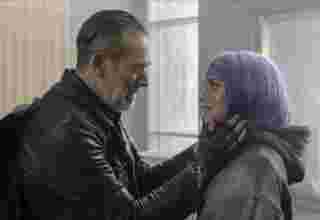
Warrior Nun may have had a lot going for it in terms of action scenes, but what truly set it apart was how much it cared for the humanity of its characters. The first season may have been slow, but it put a lot of care into developing the personal journeys of its main characters – it was not afraid to go slow, and that pays off in the show’s second season. The Warrior Nun comics, however, are another beast entirely. Hyper-sexualized nuns, cyberdemons, and plots convoluted enough to be more tiring than they were intriguing. We take a look at some of the biggest differences between the show and the comic, and why it’s probably for the best the show didn’t stick too closely to the source material.
The Costumes
The original Warrior Nun contained heavily sexualized clothing for its battle nuns, stylized in ways that rarely made sense. The Warrior Nun herself wears a regular nun’s habit until she activates her warrior self, after which her habit gains inexplicable cutouts and bares as much of her legs as possible. Lillith’s costume is far worse — a purple-pink affair that looked more like a revealed far more than it covered. Pouches, wide belts, studs, leather, and excessively impractical ornamentation and weaponry — the costumes were almost a parody of themselves.
The men, of course, tended towards the bulky, over-armored look that made them twice the size of anyone else in the room — you could always tell which male in the room was the most important by how much unnecessary space his outfit took up. It was the 90s at its worst — but then again, a manga from that era calling itself Warrior Nun was never meant to be taken seriously. Against all expectations, the show decided that it, at least, would be.
The show features outfits that are a lot more practical for warrior women who prioritize stealth over lethality but still are masters at both. What’s more, the outfits still retained a certain level of stylishness — you knew you were dealing with warriors and not grotesque parodies of them. While Ava Silva (Alba Baptista) herself wears a simple black outfit, it’s worth noting that the costumes of the other nuns manage to retain a look evocative of nuns’ habits while still clearly being battle ready.
The Characters
Almost all of the characters from the show are unrecognizable from their comic-book counterparts — and that’s not just because of the show’s more diverse casting choices. The show’s protagonist, for example, was a completely new creation, written just for the show. The main Warrior Nun comics feature Ava’s predecessor, Sister Shannon (Melina Matthews), making it clear that the show is moving on from the comics in rather significant ways. Other surprisingly new characters include Sister Beatrice (Kristina Tonteri-Young) — the show’s romantic lead as of Season 2 — and Adriel (William Miller), the main antagonist for both seasons of the show.
While some characters were created just for the show, the characters who were taken from the comics are wildly altered. Sister Lilith, for example (Lorena Andrea), goes on quite the journey through the series. Beginning as an ambitious nun from a wealthy background that put a lot of pressure on her to succeed, Lilith was meant to become the Warrior Nun before Ava came along and took the halo for herself. However, a moment of self-sacrifice set her on a journey that would end up with her being imbued with more demonic powers and embracing that side of herself in the belief that it was the right thing to do. Lilith of the comics, however, is a partially demonic princess, right from the start, with little connection to the Warrior Nun beyond the odd team-up. Comics-Lilith has been around for centuries, the comics’ resident anti-hero, born in Hell but with her own self-serving ambitions and goals beyond the war between Heaven and Hell.
There’s also Shotgun Mary (Toya Turner), who serves as a mentor of sorts to Ava Bell. On the show, Mary has her own doubts about the Church, but is dedicated to its cause and is the one who convinces Ava to (quite literally) fight on the side of the Angels. Mary remains a nun, unlike her comic-book counterpart, a motorcycle-riding, chain-smoking, sunglass-wearing blonde who left the Church a while ago but still finds herself being dragged right back into its endless conflicts.
The Villains
Another significant change from the comics is Jillian Salvius (Thekla Reuten) — genderswapped from the comics’ Julian Salvius. Julian Salvius was Sister Shannon’s first real foe, and it was implied that Julian was actually Julian the Apostate, now centuries old and dealing in both weaponry and outright Satanism, seeking to release the Devil from Hell. The Jillian Salvus of the show is a lot more conflicted. The CEO of ArqTech, Jillian may have been responsible for releasing the dangers the Church faces during the show, but it’s revealed that she’s ultimately an unwitting pawn seeking to heal her son.
There is little motivating the comics’ villains beyond the simple drive to bring about Hell on Earth, and have demons reign supreme. As convoluted as the plots could get, that was always what it boiled down to. The show complicated things — even Adriel, who seemed to be simply making a big for power, implied that he was trying to save the world from something a lot more dangerous than himself. The true of the Warrior Nun series is always one of the show’s biggest questions, but the villains of the comic were anything but subtle.
Technology
The show has an interesting relationship with technology. The Order of the Cruciform Sword may be a centuries-old order, but they moved with the times, using technology to aid their cause whenever appropriate. However, technology was a tool, not a way of life. ArqTech was another matter entirely. They believed that faith and science could co-exist, something that was a bit of an existential threat to the Church. While technology and the supernatural never fully integrated, tech was used in the show’s second season to empower the series’ antagonists to a rather powerful degree — a faith more reliant on science than spiritualism was proved to ultimately be corrupt.
This isn’t something that the comic is all that interested in exploring in any meaningful way. The comics use technology as cyberpunk flavor, and lean into that aesthetic heavily. Cybernetic upgrades for both demons and heroes, viruses with pentagrams on them infecting people’s souls, advanced weaponry for the nuns, virtual reality training simulators, and more. The show glances at complicated questions of faith vs. science, but the comics? They just wanted to have fun with it. This brings us to our last point.
Style vs. Substance
Past the relatively minor details, the most significant difference between the Warrior Nun show and its comic book counterpart is its style of storytelling. Warrior Nun Areala and the comics within that universe were all about a certain aesthetic. Overblown action taken to a ridiculous degree, redesigning the trappings of the Catholic Church to portray them as a badass, dangerous force for good, cosmic soldiers in an Eternal War. It was pure silliness that went on for far longer than it should have, coming out at a time when hyper-stylized action comics were at their peak.
The show was so much more than that. It wrote itself a group of deeply compelling characters, and wasn’t afraid to go as slowly as it took to tell their stories properly. It was crafted with care, and with much love for the world it was creating. Though it was canceled, it was a series worth celebrating, built off a comic series that was best left forgotten. Netflix’s Warrior Nun spun gold from straw, and in an era that’s constantly trying to figure out to what extent comic books influence live action showings, Warrior Nun should stand proud.
[VIA]







